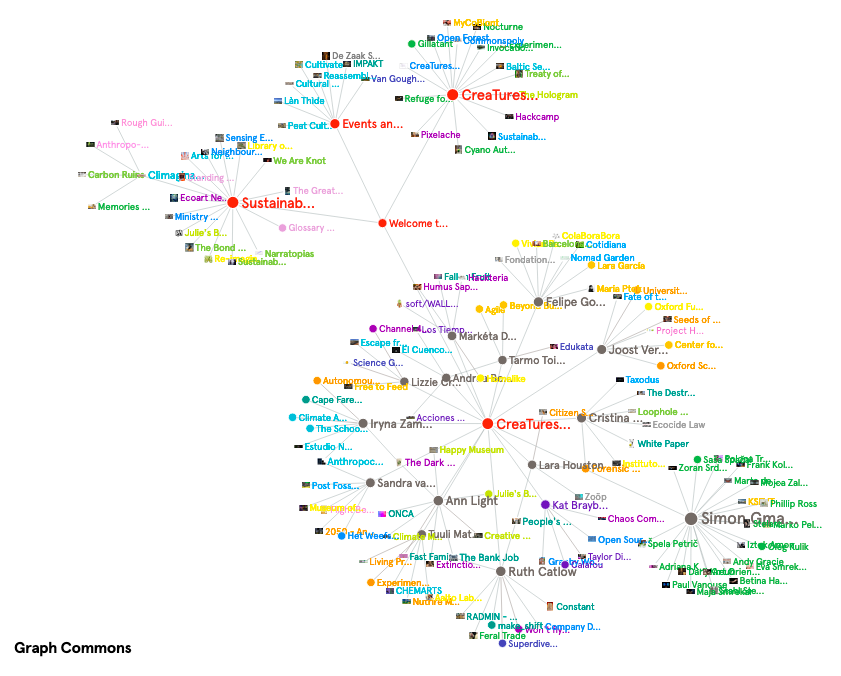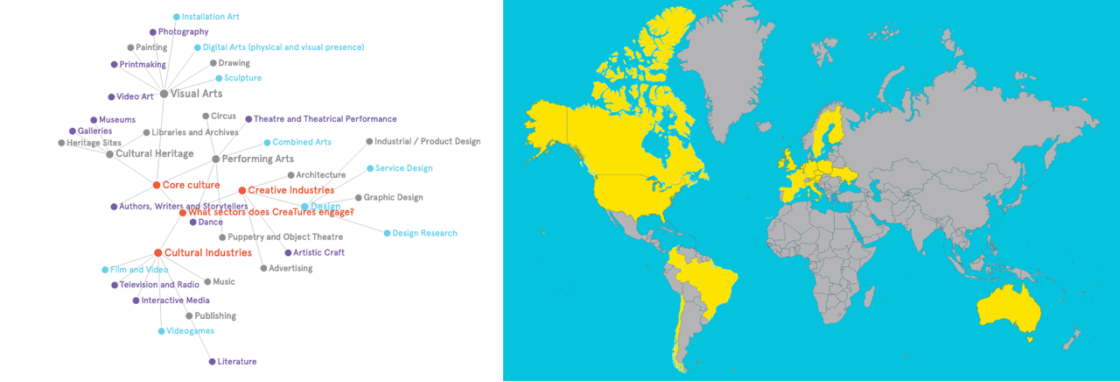In The Observatory we have collected 140 creative projects that creative practitioners and interdisciplinary researchers have found transformative. We analysed these, alongside recent research in creative and sustainability fields, to produce a list of transformative strategies that are being used to imagine and to create more sustainable worlds.
This blog post explains how we built the Observatory and the main insights that we learned from it.
Project background: What do we mean by ‘sustainability’?
The CreaTures project is situated in Europe, we recognise that many ways of life here, use too many resources. We need to imagine and to create alternative ways of life that tread more lightly on our planet. We also need to take action to repair some of the earth systems that are already breaking down, including climate collapse, widespread pollution, and biodiversity loss.
Increasingly, researchers are demonstrating that our current ways of life need to be radically changed. Sustainability is increasingly being understood as a journey, rather than a fixed destination. In sustainability science, there is a focus on ‘systems change’- for example the move from fossil fuels to renewable energy. We call this ‘eco-social’ change since it involves social and cultural change, as well as material actions (such as building wind turbines).
In recent years creative practitioners have also turned to focus on the urgent sustainability challenges that we all face. Artists, designers, and community organisers have been producing critiques of our current ways of life and developing radical alternative visions. Sustainability researchers have been inspired by these techniques and have become interested in sharing and using them. In the past, research has focussed on how artworks could send messages to members the public on how they might change their behaviour. But more recently, in systems change approaches, there has been a greater focus on how creative projects might change people’s values and worldviews.
There are some barriers to communication between sustainability researchers and creative practitioners. For example, sustainability researchers investigate how systems change over multiple years. Creative practitioners focus on changing relationships, rather than systems. Their work includes very short-term experiments (as well as life-long explorations). We think that both of these ‘eco-social’ perspectives are required for long term, meaningful change. Our role as Creatures has been to start a set of conversations to help bridge these gaps. We aim to make sure that our shared insights are accessible to all, especially policymakers who might use them to take different decisions on sustainability.
How did you collect The Observatory cases?
Creative practitioners all over the world are making works related to sustainability. There are simply too many projects to collect into one database. We have used four different methods to assemble a collection of 140 cases, from which we have extracted key insights.
1. The CreaTures ExPs (20 cases)
Our project has commissioned new works (Experimental Productions, or ExPs) from a range of creative practitioners, all of which has been studied by at least one CreaTures researcher to produce detailed case studies. This has generated a collection of in-depth data about these specific projects. View the ExPs here.
2. CreaTures Network Expert Interviews (100 cases)

We interviewed our own team members and asked them to nominate cases that they felt were transformative in relation to sustainability. This allowed creative practitioners to articulate their connections to these cases, and served as a way to identify key characteristics in the expansive field of what might be considered transformative creative practices. We analysed online documentation available for each case, which added a layer of wider yet ‘thinner’ data about transformation View the interactive graph of cases here.
3. Literature Reviews (20 cases)
We looked at sustainability transformations research and added well-known cases from within this community.
4. Governing Actor Interviews (8 cases)
We also collected cases that had been mentioned in interviews and engagement events with governing actors (such as policy makers in creative practice and sustainability, funding organisations and knowledge brokering organisations) in Scotland, the Netherlands, Finland and beyond (such as the Carasso Foundation in Spain/France).
Creative Sectors and Locations

We also took a top-down approach, where we mapped creative fields, making sure that all relevant creative sectors were represented, by using EU sector specific reports and taxonomies. View the interactive map here. We also mapped the countries that the cases come from, in order to give us an idea of the parts of the world that our work represents (and where we might need to do further research).
Where can I view your results?
The case collection is stored on the GraphCommons network mapping platform. It contains an interactive visualisation of all 140 cases, with summaries and links to their websites. Looking at documentation from these cases, in combination with academic research, we have also identified transformational strategies that are being used by creative practitioners and researchers to galvanise change. For each of these, we have written a paragraph that communicates the key idea and chosen an example case. These are listed on the CreaTures website.
What did you learn?
We identified transformational strategies being used by creative practitioners that emerged from the analysis of our case collection, alongside relevant research in sustainability science and creative fields.
Many of these key ideas were developed by practitioners and theorists outside of the project and are credited appropriately. Others have emerged from the CreaTures research. In each case, we are grateful to the practitioners and researchers that gave up their time for an interview or seminar.